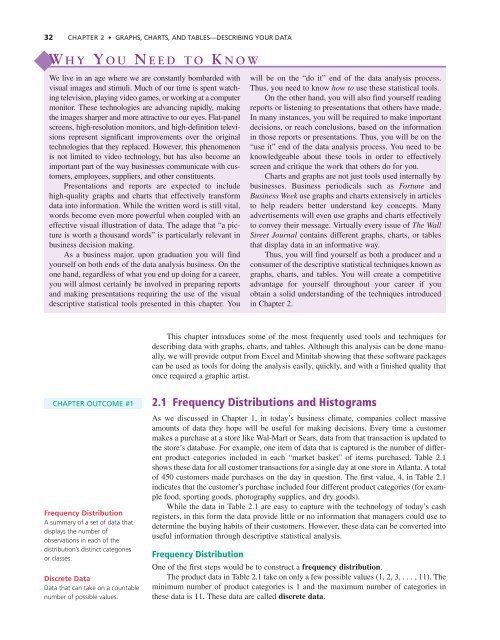Chapter 2: Graphs, Charts, and Tables--Describing Your Data
Chapter 2: Graphs, Charts, and Tables--Describing Your Data
Chapter 2: Graphs, Charts, and Tables--Describing Your Data
Create successful ePaper yourself
Turn your PDF publications into a flip-book with our unique Google optimized e-Paper software.
32 CHAPTER 2 • GRAPHS, CHARTS, AND TABLES—DESCRIBING YOUR DATA<br />
W HY Y OU N EED TO K NOW<br />
We live in an age where we are constantly bombarded with<br />
visual images <strong>and</strong> stimuli. Much of our time is spent watching<br />
television, playing video games, or working at a computer<br />
monitor. These technologies are advancing rapidly, making<br />
the images sharper <strong>and</strong> more attractive to our eyes. Flat-panel<br />
screens, high-resolution monitors, <strong>and</strong> high-definition televisions<br />
represent significant improvements over the original<br />
technologies that they replaced. However, this phenomenon<br />
is not limited to video technology, but has also become an<br />
important part of the way businesses communicate with customers,<br />
employees, suppliers, <strong>and</strong> other constituents.<br />
Presentations <strong>and</strong> reports are expected to include<br />
high-quality graphs <strong>and</strong> charts that effectively transform<br />
data into information. While the written word is still vital,<br />
words become even more powerful when coupled with an<br />
effective visual illustration of data. The adage that “a picture<br />
is worth a thous<strong>and</strong> words” is particularly relevant in<br />
business decision making.<br />
As a business major, upon graduation you will find<br />
yourself on both ends of the data analysis business. On the<br />
one h<strong>and</strong>, regardless of what you end up doing for a career,<br />
you will almost certainly be involved in preparing reports<br />
<strong>and</strong> making presentations requiring the use of the visual<br />
descriptive statistical tools presented in this chapter. You<br />
will be on the “do it” end of the data analysis process.<br />
Thus, you need to know how to use these statistical tools.<br />
On the other h<strong>and</strong>, you will also find yourself reading<br />
reports or listening to presentations that others have made.<br />
In many instances, you will be required to make important<br />
decisions, or reach conclusions, based on the information<br />
in those reports or presentations. Thus, you will be on the<br />
“use it” end of the data analysis process. You need to be<br />
knowledgeable about these tools in order to effectively<br />
screen <strong>and</strong> critique the work that others do for you.<br />
<strong>Charts</strong> <strong>and</strong> graphs are not just tools used internally by<br />
businesses. Business periodicals such as Fortune <strong>and</strong><br />
Business Week use graphs <strong>and</strong> charts extensively in articles<br />
to help readers better underst<strong>and</strong> key concepts. Many<br />
advertisements will even use graphs <strong>and</strong> charts effectively<br />
to convey their message. Virtually every issue of The Wall<br />
Street Journal contains different graphs, charts, or tables<br />
that display data in an informative way.<br />
Thus, you will find yourself as both a producer <strong>and</strong> a<br />
consumer of the descriptive statistical techniques known as<br />
graphs, charts, <strong>and</strong> tables. You will create a competitive<br />
advantage for yourself throughout your career if you<br />
obtain a solid underst<strong>and</strong>ing of the techniques introduced<br />
in <strong>Chapter</strong> 2.<br />
This chapter introduces some of the most frequently used tools <strong>and</strong> techniques for<br />
describing data with graphs, charts, <strong>and</strong> tables. Although this analysis can be done manually,<br />
we will provide output from Excel <strong>and</strong> Minitab showing that these software packages<br />
can be used as tools for doing the analysis easily, quickly, <strong>and</strong> with a finished quality that<br />
once required a graphic artist.<br />
CHAPTER OUTCOME #1<br />
Frequency Distribution<br />
A summary of a set of data that<br />
displays the number of<br />
observations in each of the<br />
distribution’s distinct categories<br />
or classes.<br />
Discrete <strong>Data</strong><br />
<strong>Data</strong> that can take on a countable<br />
number of possible values.<br />
2.1 Frequency Distributions <strong>and</strong> Histograms<br />
As we discussed in <strong>Chapter</strong> 1, in today’s business climate, companies collect massive<br />
amounts of data they hope will be useful for making decisions. Every time a customer<br />
makes a purchase at a store like Wal-Mart or Sears, data from that transaction is updated to<br />
the store’s database. For example, one item of data that is captured is the number of different<br />
product categories included in each “market basket” of items purchased. Table 2.1<br />
shows these data for all customer transactions for a single day at one store in Atlanta. A total<br />
of 450 customers made purchases on the day in question. The first value, 4, in Table 2.1<br />
indicates that the customer’s purchase included four different product categories (for example<br />
food, sporting goods, photography supplies, <strong>and</strong> dry goods).<br />
While the data in Table 2.1 are easy to capture with the technology of today’s cash<br />
registers, in this form the data provide little or no information that managers could use to<br />
determine the buying habits of their customers. However, these data can be converted into<br />
useful information through descriptive statistical analysis.<br />
Frequency Distribution<br />
One of the first steps would be to construct a frequency distribution.<br />
The product data in Table 2.1 take on only a few possible values (1, 2, 3, ..., 11). The<br />
minimum number of product categories is 1 <strong>and</strong> the maximum number of categories in<br />
these data is 11. These data are called discrete data.
















